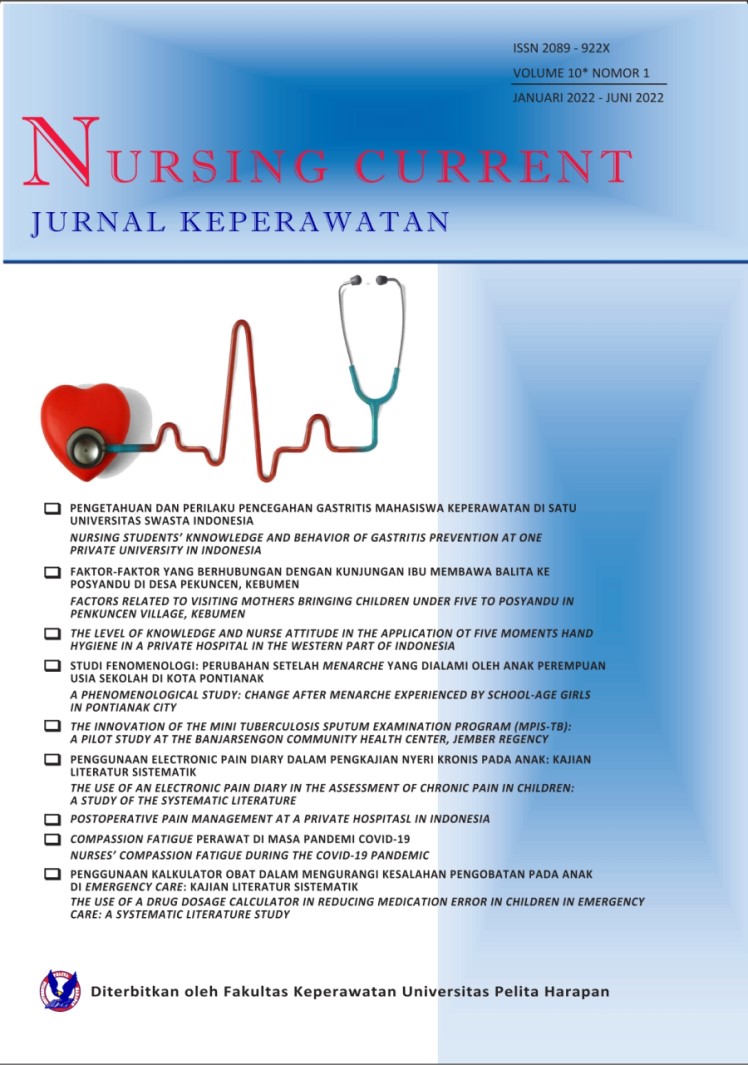POSTOPERATIVE PAIN MANAGEMENT IN A PRIVATE HOSPITAL IN CENTRAL INDONESIA
DOI:
https://doi.org/10.19166/nc.v10i1.5184Kata Kunci:
Pain scale, Pain management, PostoperativeAbstrak
Postoperative patients' most prevalent and expected complaint is pain. The pain might interfere with patients' daily activities and, if left untreated, can lead to neurogenic shock. The involvement of nurses in pain management for postoperative patients is critical, both independently and collaboratively, via pharmaceutical and non-pharmacological therapy. The goal of this study was to determine how pain was managed in postoperative patients in a private hospital in Central Indonesia. In this study, a quantitative descriptive method was applied, and a total of 137 documents were gathered from January to March 2018 utilizing a total sample technique in May 2018. According to the findings of the study, 114 patients (83.2 %) reported mild pain, 17 patients (12.4 %) reported moderate pain, 6 patients (4.4 %) reported no discomfort, and no one reported severe pain. It also revealed that 72 patients (53%) received a combination of pharmacology and non-pharmacology pain therapy, 54 patients (39%) received pharmacological pain management, and the remaining four patients (3%) received nonpharmacological pain management. Nurses were found to use a combination of both therapies more than either pharmacological or nonpharmacological treatment alone.
Referensi
Black, J. M., & Hawks, J. H. (2009). Medical-surgical nursing: Clinical management for positive outcomes (8th. ed). Elsevier.
Chanif, C., Petpichetchian, W., & Wimo, W. (2012). Acute postoperative pain of Indonesian patients after abdominal surgery. Nurse Media Journal of Nursing, 2(2), 409-420. https://ejournal.undip.ac.id/index.php/medianers/article/view/3986.
Gedara, G. P. S., Kauppinen, R., & Louarn, S. L. (2015). Post-operative pain management methods and nursing role in the relief of pain of total knee replacement patients. https://pdfs.semanticscholar.org/3f08/d30263d900b05e85c1db3e885fc62ef6f5c1.pdf
El Geziry, A., Toble, Y., Al Kadhi, F., & Pervaiz, M., & Al Nobani, M. (2018). Non-pharmacological pain management. In N. A. Shallik (Ed.), Pain Management in Special Circumstances. IntechOpen. https://doi.org/10.5772/intechopen.79689
Khalil, N. S. (2018). Critical care nurses' use of non-pharmacological pain management methods in Egypt. Applied Nursing Research, 44, 33-38. https://doi.org/10.1016/j.apnr.2018.09.001
Kia, Z., Allahbakhsian, M., Ilkhani, M., Nasiri, M., & Allahbakhsian, A. (2021). Nurses’ use of non-pharmacological pain management methods in intensive care units: A descriptive cross-sectional study. Complementary Therapies in Medicine, 58. https://doi.org/10.1016/j.ctim.2021.102705
Malek, J., Pavel, S., Bejsovec, D., Gabrhelik, T., Hnilicova, M., ”¦ & Mixa, V. (2017). Postoperative pain management. Praha: Mlada Fronta. https://management.ind.in/forum/attachments/f2/39049d1586398178-postoperative-pain-postoperative-pain.pdf
McCartney, M. (2015). Margaret McCartney: Honesty, placebos, and pain care. BMJ, 351, h5103. https://doi.org/10.1136/bmj.h5103
Mwaka, G., Thikra, S., & Mung’ayi, V. (2013). The prevalence of postoperative pain in the first 48 hours following day surgery at a tertiary hospital in Nairobi. African Health Sciences, 13(3). https://doi.org/10.4314/ahs.v13i3.36
Nurhafizah, & Erniyati. (2012). Strategi koping dan intensitas nyeri pasien post operasi di ruang rindu B2A RSUP H. Adam Malik Medan. Jurnal Keperawatan Klinis 1(1). https://jurnal.usu.ac.id/index.php/jkk/article/view/101/90
International Association for the Study of Pain (IASP). (2017). Pain terms. https://www.iasp-pain.org/terminology?navItemNumber=576#Pain
Potter, P. A., Perry, A. G., Stockert, P. A., & Hall, A. M. (2013). Fundamentals of nursing (8th ed.). Mosby.
Saragih, A., Pangemanan, A., & Lumbantoruan, S. M. (2017). Gambaran penatalaksanaan nyeri pada pasien post operasi di ruang rawat inap Rumah Sakit Siloam Dhirga Surya Medan (Unpublished Bachelor's Thesis). Universitas Pelita Harapan, Tangerang.
Slater, D., Kunnathil, S., McBride, J., & Koppala, R. (2010). Pharmacology of nonsteroidal antiinflammatory drugs and opioids. Seminars in Interventional Radiology, 27(04), 400-411. https://doi.org/10.1055/s-0030-1267855
US Pain Foundation. (2017). Patient Bill of Rights. https://uspainfoundation.org/wp-content/uploads/2017/11/patient-bill-of-rights-combined.pdf
Unduhan
File Tambahan
Diterbitkan
Cara Mengutip
Terbitan
Bagian
Lisensi
Authors who publish with this journal agree to the following terms:
1) Authors retain copyright and grant the journal right of first publication with the work simultaneously licensed under a Creative Commons Attribution License (CC-BY-SA 4.0) that allows others to share the work with an acknowledgement of the work's authorship and initial publication in this journal.
2) Authors are able to enter into separate, additional contractual arrangements for the non-exclusive distribution of the journal's published version of the work (e.g., post it to an institutional repository or publish it in a book), with an acknowledgement of its initial publication in this journal.
3) Authors are permitted and encouraged to post their work online (e.g., in institutional repositories or on their website). The final published PDF should be used and bibliographic details that credit the publication in this journal should be included.

This work is licensed under a Creative Commons Attribution-ShareAlike 4.0 International License.






